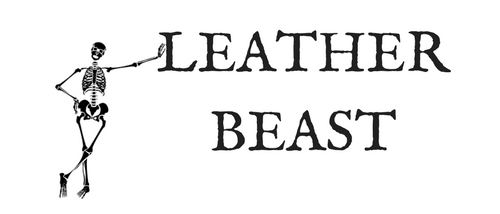Linen Thread And Why You Should Use It
I am always seeking that perfectly crafted slanted saddlestitch. The stitch that screams skill, precision and attention! Maybe we're all searching for the same thing?
I've explored many reasons for why my stitching, though it wasn't bad, was certainly far from perfect and i've found a few contributing factors relating to thread.
Thread type, size and material is all very important when creating beautiful rows of saddle-stitching.
There are of course, so many other factors that you have to get just right too, but today I want to focus on threads. Thread choice can make a huge difference in the quality of your work.
Lets talk about brands, materials and thread size.
Legendary Thread Brands
My 2 favorite Linen thread brands are Fil Au Chinois lin Cable and Irish Barbour thread.
Fil Au Chinois is a French brand of linen thread that has been around since about 1827 and became very popular in the 1850s. The brand started at a time in France when there was great interest in Chinese culture, thus the name Fill Au Chinois Lin Cable, which means Chinese wire or thread.
Around the time of the introduction of the home sewing machine in the mid to late 1800s, consumers started hand sewing less and less and the company began to experience a period of decline. In 2007 the brand was revived by J Toulemonde, a company who has been in the thread making business since 1903. The company now serves mainly boutique and luxury brands that are still seeking the quality that Fil Au Chinois linen thread provides.
Irish Barbour thread is another great choice of linen thread that you might be familiar with.
The Barbour Mill Company started in 1784 in County Down, Ireland.
By the end of the 19th century the company had expanded it's factories to the US and Germany and merged with competitors and was estimated to be the largest producer of linen thread in the world.
In 1898 they became The Linen Thread Company Ltd. As with Fil Au Chinois, they also began to experience a period of decline with the introduction of the home sewing machine and as synthetic threads began to be popular and available at lower price points in the 1900s.
In 1999 the Linen Thread Company Ltd merged with J P Coats where they still produce quality linen threads today.
Image © McBurneyandBlack.com
Synthetic or Linen Thread?
From what I see on the forums, videos and blog comment sections, the hot debate is about synthetic or natural thread. For me it's a no brain-er.
Quality materials are your best chance at a quality result.
Linen thread comes from the flax plant and has many naturally occurring beneficial properties.
Benefits of Linen Thread
Linen thread does not stretch or give over time, it is very strong and durable, and due to the natural fibers and the way that they're twisted together in the manufacturing process, it knots very well.
Linen is actually 5% stronger when wet, which makes it totally acceptable to be used gently in outdoor environments without worrying about it degrading.
This makes sense, considering that it has been the material of choice of saddle makers for centuries which, arguably, get the most stress of any leathergoods.
Think about it... saddles and equestrian tack are sat on and used on horses in often times muddy conditions and have to remain strong enough to carry the weight of a man. That's some serious stress!
Linen is a material that has been used in many industries because of its strength and durability.
From bookbinders to leatherworkers and sailors using it for their linen sails to a housewife's linen dishcloth - It's no wonder that it's been a diverse and optimal material for hundreds of years.
Thread Size
Thread size is something that after I started to experiment with it, my work totally changed.
I tried using a heavier thread and to my surprise, voila my stitches look so much better!
Thread size can be complicated as there are 4 different methods of measure (I won't go into this history here, but there is a very interesting history behind methods of measure that i'll save for another post) that any one company could be using.
The Fil Au Chinios linen thread comes in 4 different sizes and the smaller the number, the thicker the thread.
The smallest number, 332 is the thickest thread and the best for leathergoods that will need to be quite durable, like handbags and briefcases.
The size of your pricking irons or stitching chisels, is also a consideration. If your stitches are spaced out, you'll may want to use the thicker thread. If they're more tightly packed together, then the thinner, 832 might be want you want to use.
Photo from Fine Leatherworking
Barbour thread uses 2 sets of numbers to describe it's thread size. 25/3 and 18/3 are common sizes used for leatherwork.
If we look at size 18/3, the first number describes the gauge of the thread and the 2nd number is the number of strands that make up the thread. The same holds true here as with the Fil Au Chinois thread, the smaller the gauge the thicker the thread. So 18/3 thread is 3 plies of size 18 thread and this is thicker then 25/3 thread.
I hope this helps you with your decision of what type of thread to use in your project. Second to your leather choice, thread is one of the most important things to consider.
It's purpose at the simplest level is holding the project together and the aesthetic appearance. Linen thread is sure to achieve both of these goals with ease.
Do you have an alternate thread preference?
Check out the 1 page Thread Reference eGuide that I've created. You can download this by entering your below.




